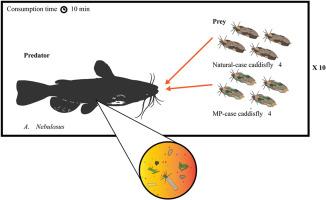Caddisfly larvae (Trichoptera: Limnephilidae) facilitate the uptake of microplastics by a freshwater fish (Ameiurus nebulosus)
IF 7.3
2区 环境科学与生态学
Q1 ENVIRONMENTAL SCIENCES
引用次数: 0
Abstract
Microplastics are pervasive in inland waters and are entering aquatic food webs through diverse pathways. Caddisflies (Trichoptera) are common prey items for fishes and some aquatic birds; they have been found to incorporate microplastic particles in their larval cases, which are a potential vector of plastic transmission to higher trophic levels. We examined this novel pathway in two sets of experiments. First, we exposed caseless Limnephilus larvae to either i) a 50% mixture of polyethylene terephthalate (PET) microfragments and natural materials, or ii) 100% natural materials, and compared their subsequent case construction. Limnephilus consistently incorporated PET into their cases, even when natural material was available. However, only 5% of larvae constructed a case completely covering the abdominal region of their body when they used PET fragments. Cases incorporating plastic had a lower mass than those constructed entirely from natural materials, regardless of the mass of the larvae. These findings suggest that the incorporation of microplastics affects case structure and, potentially, functionality. In a subsequent set of experiments, we offered four partially plastic-cased and four natural-cased caddisfly larvae to a benthivorous fish, the brown bullhead (Ameiurus nebulosus). Ninety percent (9/10) of the bullheads selected a larva with plastic in its case over a larva with a fully natural case as the first prey they attacked. Overall, consumption of plastic-cased larvae represented 63% of all prey consumed, suggesting that the incorporation of PET microplastic fragments in case matrices renders larval caddisflies more vulnerable to predation. Case-building caddisflies can thus facilitate the transfer of plastic and associated contaminants into aquatic food webs.

粉虱幼虫(毛翅目:粉虱科)促进淡水鱼对微塑料的吸收。
微塑料在内陆水域普遍存在,并通过多种途径进入水生食物网。球虱(毛翅目)是鱼类和一些水鸟的常见猎物;已经发现它们的幼虫体内含有微塑料颗粒,这是塑料传播到更高营养水平的潜在载体。我们在两组实验中检验了这种新途径。首先,我们将无壳Limnephilus幼虫暴露于1)50%聚对苯二甲酸乙二醇酯(PET)微碎片和天然材料的混合物,或2)100%天然材料中,并比较它们随后的壳结构。Limnephilus始终将PET纳入他们的案例中,即使有天然材料。然而,当使用PET碎片时,只有5%的幼虫构建了一个完全覆盖腹部区域的病例。不管幼虫的质量如何,含有塑料的箱子比完全由天然材料制成的箱子的质量要低。这些发现表明,微塑料的掺入会影响外壳的结构,并可能影响其功能。在后来的一组实验中,我们把四种部分塑料壳和四种自然壳的球蝇幼虫喂给一种腹食性鱼,棕头鱼。90%(9/10)的牛头鱼选择了装着塑料壳的幼虫,而不是装着完全自然壳的幼虫作为它们攻击的第一个猎物。总体而言,塑料外壳幼虫的消耗量占所有猎物消耗量的63%,这表明在外壳基质中加入PET微塑料碎片使幼虫更容易受到捕食。因此,制造病例的球虱可以促进塑料和相关污染物进入水生食物网。
本文章由计算机程序翻译,如有差异,请以英文原文为准。
求助全文
约1分钟内获得全文
求助全文
来源期刊

Environmental Pollution
环境科学-环境科学
CiteScore
16.00
自引率
6.70%
发文量
2082
审稿时长
2.9 months
期刊介绍:
Environmental Pollution is an international peer-reviewed journal that publishes high-quality research papers and review articles covering all aspects of environmental pollution and its impacts on ecosystems and human health.
Subject areas include, but are not limited to:
• Sources and occurrences of pollutants that are clearly defined and measured in environmental compartments, food and food-related items, and human bodies;
• Interlinks between contaminant exposure and biological, ecological, and human health effects, including those of climate change;
• Contaminants of emerging concerns (including but not limited to antibiotic resistant microorganisms or genes, microplastics/nanoplastics, electronic wastes, light, and noise) and/or their biological, ecological, or human health effects;
• Laboratory and field studies on the remediation/mitigation of environmental pollution via new techniques and with clear links to biological, ecological, or human health effects;
• Modeling of pollution processes, patterns, or trends that is of clear environmental and/or human health interest;
• New techniques that measure and examine environmental occurrences, transport, behavior, and effects of pollutants within the environment or the laboratory, provided that they can be clearly used to address problems within regional or global environmental compartments.
 求助内容:
求助内容: 应助结果提醒方式:
应助结果提醒方式:


